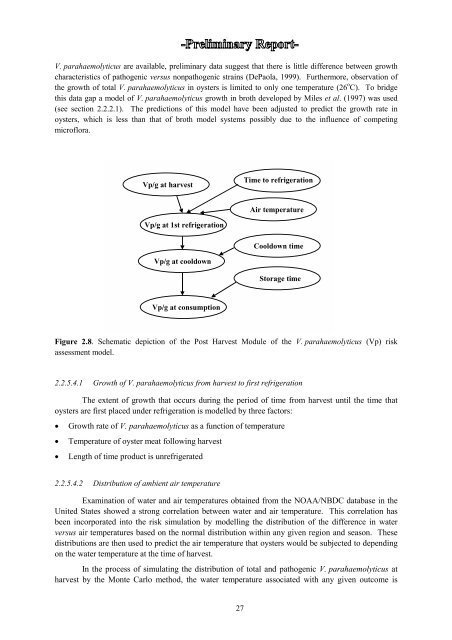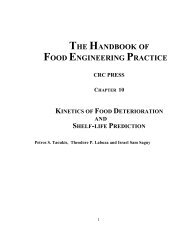Vibrio in seafood - FAO.org
Vibrio in seafood - FAO.org
Vibrio in seafood - FAO.org
Create successful ePaper yourself
Turn your PDF publications into a flip-book with our unique Google optimized e-Paper software.
V. parahaemolyticus are available, prelim<strong>in</strong>ary data suggest that there is little difference between growthcharacteristics of pathogenic versus nonpathogenic stra<strong>in</strong>s (DePaola, 1999). Furthermore, observation ofthe growth of total V. parahaemolyticus <strong>in</strong> oysters is limited to only one temperature (26 o C). To bridgethis data gap a model of V. parahaemolyticus growth <strong>in</strong> broth developed by Miles et al. (1997) was used(see section 2.2.2.1). The predictions of this model have been adjusted to predict the growth rate <strong>in</strong>oysters, which is less than that of broth model systems possibly due to the <strong>in</strong>fluence of compet<strong>in</strong>gmicroflora.Vp/g at harvestTime to refrigerationAir temperatureVp/g at 1st refrigerationCooldown timeVp/g at cooldownStorage timeVp/g at consumptionFigure 2.8. Schematic depiction of the Post Harvest Module of the V. parahaemolyticus (Vp) riskassessment model.2.2.5.4.1 Growth of V. parahaemolyticus from harvest to first refrigerationThe extent of growth that occurs dur<strong>in</strong>g the period of time from harvest until the time thatoysters are first placed under refrigeration is modelled by three factors:• Growth rate of V. parahaemolyticus as a function of temperature• Temperature of oyster meat follow<strong>in</strong>g harvest• Length of time product is unrefrigerated2.2.5.4.2 Distribution of ambient air temperatureExam<strong>in</strong>ation of water and air temperatures obta<strong>in</strong>ed from the NOAA/NBDC database <strong>in</strong> theUnited States showed a strong correlation between water and air temperature. This correlation hasbeen <strong>in</strong>corporated <strong>in</strong>to the risk simulation by modell<strong>in</strong>g the distribution of the difference <strong>in</strong> waterversus air temperatures based on the normal distribution with<strong>in</strong> any given region and season. Thesedistributions are then used to predict the air temperature that oysters would be subjected to depend<strong>in</strong>gon the water temperature at the time of harvest.In the process of simulat<strong>in</strong>g the distribution of total and pathogenic V. parahaemolyticus atharvest by the Monte Carlo method, the water temperature associated with any given outcome is27














